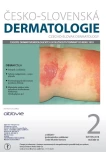Mycotic Skin Infection Caused by Arthroderma benhamiae (Trichophyton sp.)
Authors:
V. Wertzová 1; J. Bartoňová 1; B. Voxová 2
Authors‘ workplace:
Klinika nemocí kožních a pohlavních, Fakultní nemocnice Hradec Králové, přednosta doc. MUDr. Miloslav Salavec, CSc.
1; Ústav klinické mikrobiologie, Fakultní nemocnice Hradec Králové, přednostka doc. MUDr. Helena Žemličková, Ph. D.
2
Published in:
Čes-slov Derm, 93, 2018, No. 2, p. 74-77
Category:
Overview
Arthroderma benhamiae, whose asexual stadium has not been named yet, is therefore referred to as Trichophyton sp. It is a zoophilic dermatophyte which is more and more commonly reported as causative agents of mycotic skin diseases in Europe. In our conditions, the source of infection are usually guinea pigs, rabbits or other rodents. Clinically, it resembles mycotic infections caused by Microsporum canis. During Wood lamp examination green-yellow fluorescence is observed. The treatment of choice is systemic administration of terbinafine, topically are used ciclopiroxolamin and naftifin. The authors describe a case of 43-year-old woman, whose left thumb was affected by tinea caused by Artrodermna benhamiea and successfully treated with terbinafine. The source of the infection was a guinea pig.
Key words:
Arthroderma benhamiae – mycosis – dermatophyte – mycology – terbinafine
Sources
1. FRAGNER, P., HEJTMÁNEK, M. Určování dermatofytů. Olomouc: Univerzita Palackého v Olomouci 1990, s. 190
2. FUMEAUX, J., MOCK, M., NINET, B. et al. First report of Arthroderma benhamiae in Switzerland. Dermatology, 2004, 208, 3, p. 244–250.
3. GRÄSER, Y. , KUIJPERS, A. F., PRESBER, W. et al. Molecular taxonomy of Trichophyton mentagrophytes and T. tonsurans. Med Mycol. 1999, 37, 5, p. 315–330.
4. HUBKA, V., ČMOKOVÁ, A., SKOŘEPOVÁ, M. Současný vývoj v taxonomii dermatofytů a doporučení pro pojmenování klinicky významných druhů. Čes-slov. Derm., 2014, 89, 4, s. 151–165.
5. HUBKA, V., VĚTROVSKÝ, T., DOBIÁŠOVÁ, S. et al. Molekulární epidemiologie dermatofytóz v České republice: výsledky dvouleté studie. Čes-slov. Derm., 2014, 89, 4, s. 167–174.
6. KAWASAKI, M ., ASO, M., INOUE, T. et al. Two cases of tinea corporis by infection from a rabbit with Arthroderma benhamiae. Nihon Ishinkin Gakkai Zasshi, 2000, 41, 4, p. 263–267.
7. NENOFF, P., KRÜGER, C., GINTER-HANSELMAYER, G. et al. Mycology - an update. Part 1: Dermatomycoses: causative agents, epidemiology and pathogenesis. J Dtsch Dermatol Ges., 2014, 12, 3, p. 188–209.
8. NENOFF, P., UHRLAß, S., KRÜGER, C. et al. Trichophyton species of Arthroderma benhamiae – a new infectious agent in dermatology. JDDG: Journal der Deutschen Dermatologischen Gesellschaft, 2014, 12, p. 571–581.
9. SIEKLUCKI, U., OH, S.-H., HOYER, L. L. Frequent isolation of Arthroderma benhamiae from dogs with dermatophytosis. Veterinary dermatology, 2014, 25, 1, p. 39–e14.
10. SKOŘEPOVÁ, M., HUBKA, V., POLÁŠKOVÁ, S. et al. Naše první zkušenosti s infekcemi vyvolanými Arthrodema benhamiae (Trichophyton species). Čes-slov Derm., 2014, 89, 4, s. 149–212.
Labels
Dermatology & STDs Paediatric dermatology & STDsArticle was published in
Czech-Slovak Dermatology

2018 Issue 2
Most read in this issue
- Erysipelas and Cellulitis
- Mycotic Skin Infection Caused by Arthroderma benhamiae (Trichophyton sp.)
- Tubera Mulgentium – Case Description
